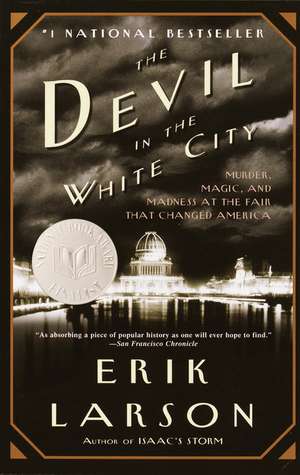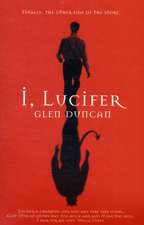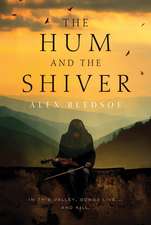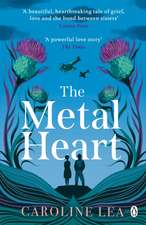The Devil in the White City: Murder, Magic, and Madness at the Fair That Changed America
Autor Erik Larsonen Limba Engleză Paperback – 31 ian 2004
Vezi toate premiile Carte premiată
| Toate formatele și edițiile | Preț | Express |
|---|---|---|
| Paperback (3) | 60.57 lei 24-30 zile | +24.50 lei 4-10 zile |
| Transworld Publishers Ltd – apr 2004 | 60.57 lei 24-30 zile | +24.50 lei 4-10 zile |
| Vintage Publishing – 31 ian 2004 | 110.75 lei 3-5 săpt. | +34.38 lei 4-10 zile |
| Large Print Press – 25 feb 2013 | 145.32 lei 3-5 săpt. |
Preț: 110.75 lei
Nou
21.19€ • 22.05$ • 17.50£
Carte disponibilă
Livrare economică 24 martie-07 aprilie
Livrare express 07-13 martie pentru 44.37 lei
Specificații
ISBN-10: 0375725601
Pagini: 464
Ilustrații: 1 MAP; 7 HALFTONES
Dimensiuni: 132 x 203 x 25 mm
Greutate: 0.45 kg
Editura: Vintage Publishing
Colecția Vintage Books
Notă biografică
Erik Larson, author of the international bestseller Isaac’s Storm, has written for Harper’s, The New Yorker, The Atlantic Monthly, and Time, where he is a contributing writer. He is a former staff writer for The Wall Street Journal. He lives in Seattle with his wife, three daughters, and assorted pets, including a golden retriever named Molly.
Extras
How easy it was to disappear:
A thousand trains a day entered or left Chicago. Many of these trains brought single young women who had never even seen a city but now hoped to make one of the biggest and toughest their home. Jane Addams, the urban reformer who founded Chicago's Hull House, wrote, "Never before in civilization have such numbers of young girls been suddenly released from the protection of the home and permitted to walk unattended upon the city streets and to work under alien roofs." The women sought work as typewriters, stenographers, seamstresses, and weavers. The men who hired them were for the most part moral citizens intent on efficiency and profit. But not always. On March 30, 1890, an officer of the First National Bank placed a warning in the help-wanted section of the Chicago Tribune, to inform female stenographers of "our growing conviction that no thoroughly honorable business-man who is this side of dotage ever advertises for a lady stenographer who is a blonde, is good-looking, is quite alone in the city, or will transmit her photograph. All such advertisements upon their face bear the marks of vulgarity, nor do we regard it safe for any lady to answer such unseemly utterances."
The women walked to work on streets that angled past bars, gambling houses, and bordellos. Vice thrived, with official indulgence. "The parlors and bedrooms in which honest folk lived were (as now) rather dull places," wrote Ben Hecht, late in his life, trying to explain this persistent trait of old Chicago. "It was pleasant, in a way, to know that outside their windows, the devil was still capering in a flare of brimstone." In an analogy that would prove all too apt, Max Weber likened the city to "a human being with his skin removed."
Anonymous death came early and often. Each of the thousand trains that entered and left the city did so at grade level. You could step from a curb and be killed by the Chicago Limited. Every day on average two people were destroyed at the city's rail crossings. Their injuries were grotesque. Pedestrians retrieved severed heads. There were other hazards. Streetcars fell from drawbridges. Horses bolted and dragged carriages into crowds. Fires took a dozen lives a day. In describing the fire dead, the term the newspapers most liked to use was "roasted." There was diphtheria, typhus, cholera, influenza. And there was murder. In the time of the fair the rate at which men and women killed each other rose sharply throughout the nation but especially in Chicago, where police found themselves without the manpower or expertise to manage the volume. In the first six months of 1892 the city experienced nearly eight hundred homicides. Four a day. Most were prosaic, arising from robbery, argument, or sexual jealousy. Men shot women, women shot men, and children shot each other by accident. But all this could be understood. Nothing like the Whitechapel killings had occurred. Jack the Ripper's five-murder spree in 1888 had defied explanation and captivated readers throughout America, who believed such a thing could not happen in their own hometowns.
But things were changing. Everywhere one looked the boundary between the moral and the wicked seemed to be degrading. Elizabeth Cady Stanton argued in favor of divorce. Clarence Darrow advocated free love. A young woman named Borden killed her parents.
And in Chicago a young handsome doctor stepped from a train, his surgical valise in hand. He entered a world of clamor, smoke, and steam, refulgent with the scents of murdered cattle and pigs. He found it to his liking.
The letters came later, from the Cigrands, Williamses, Smythes, and untold others, addressed to that strange gloomy castle at Sixty-third and Wallace, pleading for the whereabouts of daughters and daughters' children.
It was so easy to disappear, so easy to deny knowledge, so very easy in the smoke and din to mask that something dark had taken root.
This was Chicago, on the eve of the greatest fair in history.
From the Hardcover edition.
Recenzii
“A dynamic, enveloping book. . . . Relentlessly fuses history and entertainment to give this nonfiction book the dramtic effect of a novel. . . . It doesn’t hurt that this truth is stranger than fiction.” --The New York Times
"So good, you find yourself asking how you could not know this already." —Esquire
“Another successful exploration of American history. . . . Larson skillfully balances the grisly details with the far-reaching implications of the World’s Fair.”—USA Today
“As absorbing a piece of popular history as one will ever hope to find.”—San Francisco Chronicle
“Paints a dazzling picture of the Gilded Age and prefigure the American century to come.”—Entertainment Weekly
“A wonderfully unexpected book. . . Larson is a historian . . . with a novelist’s soul.”—Chicago Sun-Times
Descriere
Erik Larson—author of #1 bestseller IN THE GARDEN OF BEASTS—intertwines the true tale of the 1893 World's Fair and the cunning serial killer who used the fair to lure his victims to their death. Combining meticulous research with nail-biting storytelling, Erik Larson has crafted a narrative with all the wonder of newly discovered history and the thrills of the best fiction.
Premii
- Audies Finalist, 2004


















